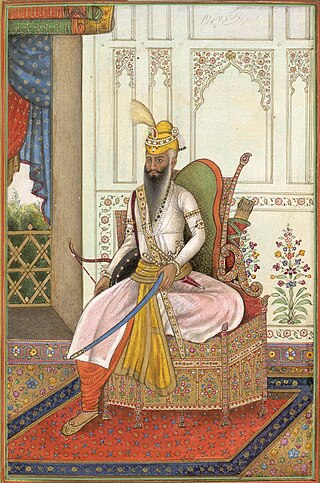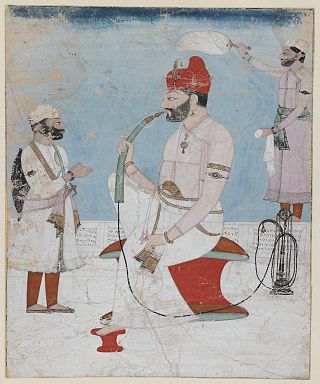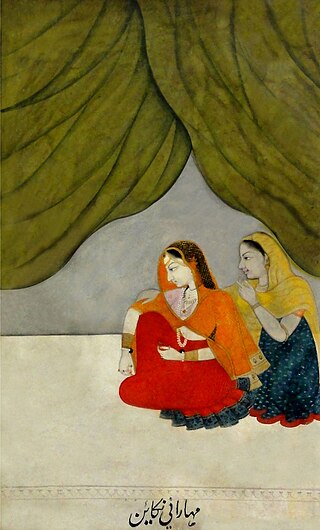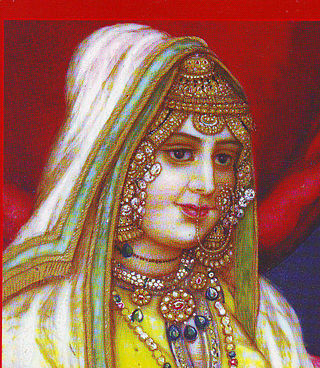
Ranjit Singh, popularly known as Sher-e-Punjab or "Lion of Punjab", was the first Maharaja of the Sikh Empire, which ruled the northwest Indian subcontinent in the early half of the 19th century. He survived smallpox in infancy but lost sight in his left eye. He fought his first battle alongside his father at age 10. After his father died, he fought several wars to expel the Afghans in his teenage years and was proclaimed as the "Maharaja of Punjab" at age 21. His empire grew in the Punjab region under his leadership through 1839.

Kangra-Lambagraon was a historical princely estate (jagir) of British India located in the present-day state of Himachal Pradesh. In 1947, the estate comprised 437 villages, encompassing an area of 324 km2. It had with a Privy Purse of Rs 70,000/- and enjoyed a revenue of approx. Rs.1,76,000/-.

The Sikh Empire was a regional power based in the Punjab region of the Indian subcontinent. It existed from 1799, when Maharaja Ranjit Singh captured Lahore, to 1849, when it was defeated and conquered by the British East India Company in the Second Anglo-Sikh War. It was forged on the foundations of the Khalsa from a collection of autonomous misls. At its peak in the 19th century, the empire extended from Gilgit and Tibet in the north to the deserts of Sindh in the south and from the Khyber Pass in the west to the Sutlej in the east as far as Oudh. It was divided into four provinces: Lahore, which became the Sikh capital; Multan; Peshawar; and Kashmir from 1799 to 1849. Religiously diverse, with an estimated population of 4.5 million in 1831, it was the last major region of the Indian subcontinent to be annexed by the British Empire.

Maha Singh, also spelt as Mahan or Mahn Singh, was the second chief of the Sukerchakia Misl. He was the eldest son of Sardar Charat Singh and Sardarni Desan Kaur Warraich. He was the father of Sher-e-Punjab Maharaja Ranjit Singh.
Katoch is a Chandravanshi Rajput clan, mostly found in the Indian state of Himachal Pradesh. Their traditional area of residence was in the Trigarta Kingdom, based at Jalandhar and at Kangra Fort. They descent from the Trigarta dynasty mentioned in the Mahabharata. Historically, they ruled from Multan, Jalandhar, and Kangra. The Multan Fort(1000-800 B.C and Kangra fort were also built by Katoch clan, establishing their antiquity. Famous subclans came into existence from Katoch Rajputs are Dadwal Dynasty, Guleria Dynasty, Sibaia Dynasty, Chib Dynasty, Jaswal Dynasty.

Sansar Chand was a Rajput ruler of the erstwhile Kangra State in what is now the Indian state of Himachal Pradesh.

Maharani Datar Kaur (born Bibi Raj Kaur Nakai; was the queen consort of Maharaja Ranjit Singh, the founder of the Sikh Empire and the mother of his successor, Maharaja Kharak Singh. She was the daughter of Sardar Ran Singh Nakai, third ruler of the Nakai Misl and Sardarni Karmo Kaur.

The Battle of Nadaun, alternatively known as the Hussaini Yudh, was fought at Nadaun, between Raja Bhim Chand of Bilaspur (Kahlur) and the Mughals under Alif Khan. Bhim Chand was supported by Guru Gobind Singh and the Mughals were supported by other hill chieftains, notably Kirpal Chand from Kangra and Dayal Chand from Bijharwal. Bhim Chand and some hill chieftains, after conclusion of Battle of Bhangani had refused to pay tribute to the Mughal emperor which led to the battle at Nadaun. The battle resulted in the victory of Bilaspur State and Sikh alliance.

Kharak Singh was the second Maharaja of the Sikh Empire. He was the eldest son of Maharaja Ranjit Singh, founder of the Sikh Empire and his consort, Maharani Datar Kaur. He succeeded his father on 27 June 1839 and reigned until his dethronement and imprisonment on 8 October 1839. He was succeeded by his only son Nau Nihal Singh.

Rani Sada Kaur was a Sikh leader. She served as the Chief of the Kanhaiya Misl from 1789 to 1821, following the death of her husband Gurbaksh Singh Kanhaiya, the heir to Jai Singh Kanhaiya, the leader of the Kanhaiya Misl, and she is sometimes referred to as Sardarni Sada Kaur.

Jai Singh Kanhaiya (1712–1793) was the founder and leader of the Kanhaiya Misl until his death. His daughter-in-law, Sada Kaur succeeded him in the leadership of the misl.

Maharani Mehtab Kaur was the first wife of Maharaja Ranjit Singh, the founder of the Sikh Empire. She was the mother of Ranjit's reputed son, Maharaja Sher Singh, who briefly became the ruler of the Sikh Empire from 1841 until his death in 1843.
Chibhal was a princely state founded by a cadet branch of the Katoch Rajputs of Kangra in 1400.

Ramgarhia Misl was a sovereign state (misl) in the Sikh Confederacy of Punjab region in present-day India and Pakistan. The misl's name is derived from Qila Ramgarh, a place located in Ramsar, near Amritsar, which was fortified and redesigned by Ramgarhia Misl chief Jassa Singh Ramgarhia. The Ramgarhia Misl was one of the twelve major Sikh misls, and held land near Amritsar.

The Nepal–Sikh War was a large scale military conflict in 1809 between the forces of the Kingdom of Nepal under Amar Singh Thapa and the Sikh Empire under general Dewan Mokham Chand.

Gurbaksh Singh Kanhaiya was the eldest son and heir of Jai Singh Kanhaiya, the chief of the Kanhaiya Misl. He was the father of Maharani Mehtab Kaur and thus, the father-in-law of Maharaja Ranjit Singh, the founder of the Sikh Empire.
Rani Raj Kaur was the wife of Maha Singh, the leader of the Sukerchakia Misl and the mother of Maharaja Ranjit Singh, the founder of the Sikh Empire. She was affectionately known as Mai Malwain after her marriage. She is also referred to as Sardarni Raj Kaur and was daughter of Raja Gajpat Singh Sidhu of Jind.
The Battle of Achal was fought in Batala in 1785 between the Sukerchakia Misl and Afghans, supported by the Ramgarhia Misl, alongside Sansar Chand,

The Hill States–Sikh Wars, also known as the Sikh–Pahari Raja Wars, was a set of battles and conflicts fought by the Sikhs and the Rajas of the Hill States located in the Sivalik Hills.















